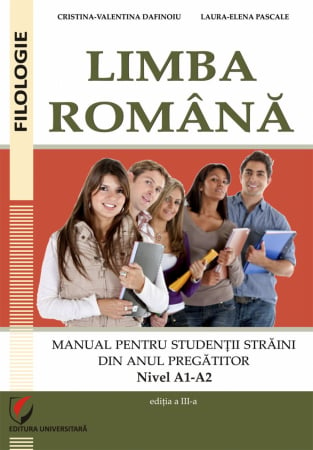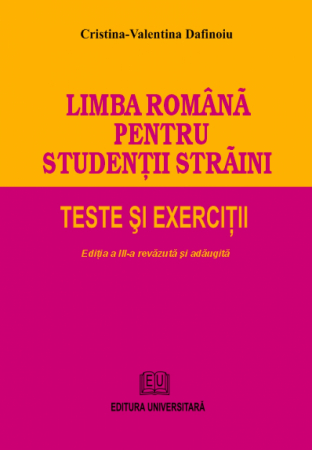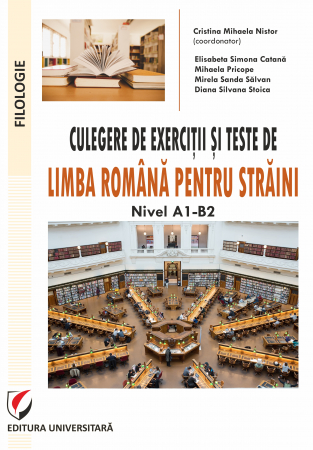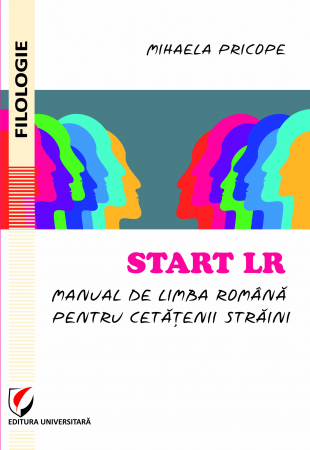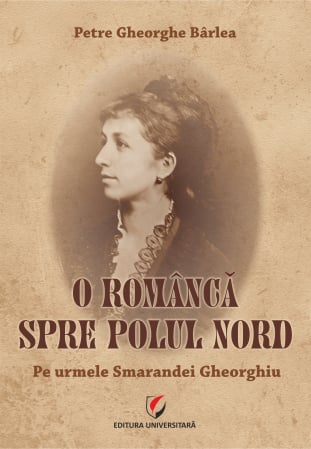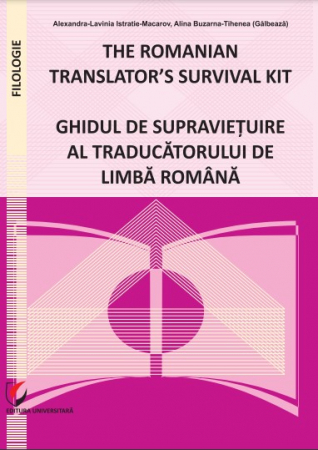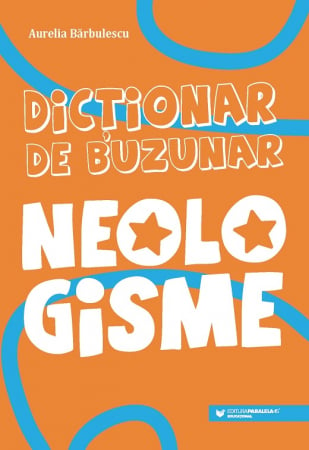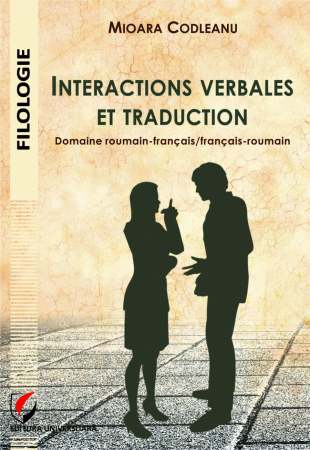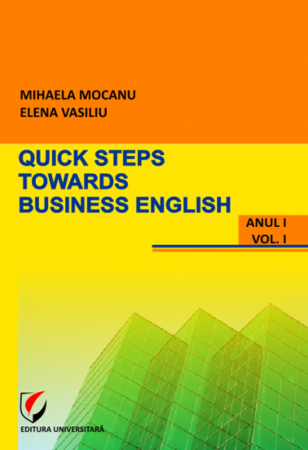Manuscript proposals: [email protected] / 0745 204 115 //// Tracking orders Individuals / Sales: 0745 200 357 / Orders Legal entities: 0721 722 783
ISBN: 978-606-28-1349-9
DOI: https://doi.org/10.5682/9786062813499
Publisher year: 2021
Edition: I
Pages: 184
Publisher: Editura Universitară
Author: Anisoara Georgiana Blindu Badea.
Product Code:
9786062813499
Do you need help?
0745 200 357
- Description
- Download (1)
- Authors
- Content
- More details
- Reviews (0)
The work signed by Anisoara Georgiana BLINDU, married BADEA, has as main objective the study of the evolution of the Romanian literary language during the seventeenth and twentieth centuries, from a specific perspective, that of logical-syntactic and discursive-pragmatic connectors. The "witness" of this evolution is the biblical text, more precisely, the text of the four "Gospels" from the New Testament, in the Romanian versions made during the last four centuries of Romanian written culture. It is understood from this selection that the translations of Christian sacred texts are considered representative of the well-kept Romanian language from the time of each version: each new interpretation from the NT capitalizes on the possibilities of the receiving language written, on the other hand.
Basically, the corpus of texts considered consists of seven "large" versions (ie, complete, as far as possible) of the Tetra-Gospel; The New Testament of Balgrad (1648); Bucharest Bible (1688); Bible from Blaj (1795); Bible from Buzau (1854), Cornilescu Bible (1924), The Bible in use (1914/1934/1982), Bible diortosite by Valeriu Anania (2001). To these are added, for the punctual analysis of some grammatical or lexico-semantic aspects, the references to other editions, such as the Bible from Sibiu (1856 1858), texts from the fragmentary translations from the 17th - 18th centuries s.a. Also, for the analysis of some forms and functions of syntactic connectors, comparisons were made with various other books of the New Testament, but also of the Old Testament.
The recourse to the method was determined by the theme of the paper, on the one hand, and by the specifics of the corpus of texts, on the other hand. Basically, grammatical connectors impose a multitude of perspectives in the analysis of their forms and behavior in sentences and phrases. Both the proper conjunctions (simple, compound, locutions) and their substitutes (pronouns and relative adverbs, various connective elements of verbal, prepositional or substantive origin) belong, naturally, to the morphological structure of the language system. But their role in communication is logical-syntactic, so any analysis must take into account the whole more or less normalized structure of the language in question. Secondly, the perspective of treatment is clearly diachronic, because the same connector in a New Testament verse is pursued in its syntactic, pragmatic, discursive forms, topics and functions in different versions, over the four centuries of evolution of translations. from sacred texts.
But the general image on the subsystem of Romanian language connectors was created in the paper through a synchronous presentation of them. The coding of the current situation of the connectors was capitalized, but also of the situation valid, in general, for the three important stages of the language evolution: 1521-1688; 1688-1780; 1780-1920. Third, any biblical text rendered in a modern language necessarily presupposes a translational perspective, because any "modern" biblical text is, in fact, the contact between the base language (Greek of the New Testament, in this case) and the target language. Romanian, in the present case). In addition, such an approach forces the researcher to proceed with the confrontation with the intermediate versions (from Latin, Slavonic, from languages such as Middle Bulgarian, Ukrainian, Hungarian, German, French, etc.), used as control texts for translation. In fact, often such intermediaries even served as source texts, more or less declared as such, in enough Romanian versions of wide circulation.
The connectors are selected by quoting verse phrases from several versions and are compared with the equivalents in the basic text, Greek, followed by those in Latin, often with references to Slavonic forms, etc.
All this means appealing to the principles, working methods and tools of several fields in the whole sciences of the word: historical grammar and descriptive-normative grammar, then translation, with its superordinates born from the rich hermeneutics of historical comparativism, respectively contrastive-typological grammar, terminology (transformed from the subdomain of lexicon study, into independent science), the history of culture, etc. In their turn, stylistics and pragmatics are imposed in such a research by the values with great logical, discursive and grammatical load, on the one hand, and ideological, id is dogmatic, on the other hand, of any biblical text.
The structure of the paper is also due to the specificity of such a research topic. It took a long chapter devoted to the description of the subsystem of connectors in the Romanian language, as it appears in modern grammars (GAR, GALR, GBLR), but also in the grammars and histories of the old Romanian language. Then, in a few paragraphs inserted in the following chapters, information is synthesized about the connectors in Hellenic I-III centuries AD, even in Latin, sometimes - as I said - and with reference to the Slavonic / Slavic forms they will have under the eyes of the Romanian interpreters.
Basically, the corpus of texts considered consists of seven "large" versions (ie, complete, as far as possible) of the Tetra-Gospel; The New Testament of Balgrad (1648); Bucharest Bible (1688); Bible from Blaj (1795); Bible from Buzau (1854), Cornilescu Bible (1924), The Bible in use (1914/1934/1982), Bible diortosite by Valeriu Anania (2001). To these are added, for the punctual analysis of some grammatical or lexico-semantic aspects, the references to other editions, such as the Bible from Sibiu (1856 1858), texts from the fragmentary translations from the 17th - 18th centuries s.a. Also, for the analysis of some forms and functions of syntactic connectors, comparisons were made with various other books of the New Testament, but also of the Old Testament.
The recourse to the method was determined by the theme of the paper, on the one hand, and by the specifics of the corpus of texts, on the other hand. Basically, grammatical connectors impose a multitude of perspectives in the analysis of their forms and behavior in sentences and phrases. Both the proper conjunctions (simple, compound, locutions) and their substitutes (pronouns and relative adverbs, various connective elements of verbal, prepositional or substantive origin) belong, naturally, to the morphological structure of the language system. But their role in communication is logical-syntactic, so any analysis must take into account the whole more or less normalized structure of the language in question. Secondly, the perspective of treatment is clearly diachronic, because the same connector in a New Testament verse is pursued in its syntactic, pragmatic, discursive forms, topics and functions in different versions, over the four centuries of evolution of translations. from sacred texts.
But the general image on the subsystem of Romanian language connectors was created in the paper through a synchronous presentation of them. The coding of the current situation of the connectors was capitalized, but also of the situation valid, in general, for the three important stages of the language evolution: 1521-1688; 1688-1780; 1780-1920. Third, any biblical text rendered in a modern language necessarily presupposes a translational perspective, because any "modern" biblical text is, in fact, the contact between the base language (Greek of the New Testament, in this case) and the target language. Romanian, in the present case). In addition, such an approach forces the researcher to proceed with the confrontation with the intermediate versions (from Latin, Slavonic, from languages such as Middle Bulgarian, Ukrainian, Hungarian, German, French, etc.), used as control texts for translation. In fact, often such intermediaries even served as source texts, more or less declared as such, in enough Romanian versions of wide circulation.
The connectors are selected by quoting verse phrases from several versions and are compared with the equivalents in the basic text, Greek, followed by those in Latin, often with references to Slavonic forms, etc.
All this means appealing to the principles, working methods and tools of several fields in the whole sciences of the word: historical grammar and descriptive-normative grammar, then translation, with its superordinates born from the rich hermeneutics of historical comparativism, respectively contrastive-typological grammar, terminology (transformed from the subdomain of lexicon study, into independent science), the history of culture, etc. In their turn, stylistics and pragmatics are imposed in such a research by the values with great logical, discursive and grammatical load, on the one hand, and ideological, id is dogmatic, on the other hand, of any biblical text.
The structure of the paper is also due to the specificity of such a research topic. It took a long chapter devoted to the description of the subsystem of connectors in the Romanian language, as it appears in modern grammars (GAR, GALR, GBLR), but also in the grammars and histories of the old Romanian language. Then, in a few paragraphs inserted in the following chapters, information is synthesized about the connectors in Hellenic I-III centuries AD, even in Latin, sometimes - as I said - and with reference to the Slavonic / Slavic forms they will have under the eyes of the Romanian interpreters.
-
Syntactic connectors in the Romanian New Testament versions
Download
ANISOARA GEORGIANA BLINDU BADEA
Born in Voinesti-Dambovita, "the homeland of apples", on May 9, 1988, Anisoara Badea graduated from the Normal School, after which she enrolled in university studies of Romanian-English Philology, in Bucharest. He has a master's degree in Didactics and a doctorate in Philology, specializing in "General Linguistics and Romanian Linguistics", at the "Ovidius" University of Constanta, under the coordination of Professor Petre Gheorghe Barlea.
He participated in several scientific events in the country, supporting communications about the particularities of the didactic discourse or about the syntactic structures of the old and modern Romanian language. The two components of his profile as a researcher are found in the activity he carries out at the department, in pre-university education, as a teacher of Romanian language and literature.
Born in Voinesti-Dambovita, "the homeland of apples", on May 9, 1988, Anisoara Badea graduated from the Normal School, after which she enrolled in university studies of Romanian-English Philology, in Bucharest. He has a master's degree in Didactics and a doctorate in Philology, specializing in "General Linguistics and Romanian Linguistics", at the "Ovidius" University of Constanta, under the coordination of Professor Petre Gheorghe Barlea.
He participated in several scientific events in the country, supporting communications about the particularities of the didactic discourse or about the syntactic structures of the old and modern Romanian language. The two components of his profile as a researcher are found in the activity he carries out at the department, in pre-university education, as a teacher of Romanian language and literature.
PREFACE (P. Gh. Barlea) / 9
ABBREVIATIONS AND ABBREVIATIONS / 13
INTRODUCTION / 17
1. Argument / 17
2. Research stage / 20
3. Working material / 21
4. Working methods / 22
5. Terminological specifications / 24
CHAPTER I
MODERN EDITIONS OF THE ROMANIAN BIBLE / 26
1.1. Monumenta Linguae Dacoromanorum (MLD) / 26
1.2. Bible 1688 - a new academic edition / 33
1.3. Usual editions vs author editions / 38
1.4. Conclusions regarding the Romanian editions of the Bible / 49
CHAPTER II
SYSTEM OF SYNTACTIC CONNECTORS IN MODERN ROMANIAN GRAMMARS / 51
2.1. Synchronous perspective / 51
2.1.1. Theoretical vision / 51
2.1.2. The evolution of a definition / 52
2.1.3. Internal structure of connectors, evolution and topic / 55
2.1.4. Inventory and syntactic-semantic description of connectors in Romanian / 57
2.1.5. Conclusions on the place of syntactic connectors in modern grammars / 82
2.2. Diachronic perspective / 83
2.2.1. Between grammars and histories of the Romanian language / 83
2.2.2. The evolution of the system of syntactic connectors in Old Romanian / 86
2.2.3. Conclusions regarding the historical evolution of conjunctional type structures / 98
CHAPTER III
LOGICAL-SYNTACTIC CONNECTORS IN THE ROMANIAN NEW TESTAMENT VERSIONS / 100
3.1. Junction and juxtaposition / 100
3.2. Paratactic structures / 101
3.3. Syntactic coordination connectors / 103
3.3.1. Copulative coordination / 103
3.3.2. Adversative coordination / 107
3.3.3. Disjunctive coordination / 111
3.3.4. Concluding coordination / 113
3.3.5. Correlation structures at the coordination level / 116
3.3.6. Conclusions on connectors for syntactic coordination / 116
3.4. Syntactic subordination connectors / 117
3.4.1. Uncircumstantial subordination / 118
3.4.1.1. Subjective / 118
3.4.1.2. Predicative / 120
3.4.1.3. Attributive / 121
3.4.1.4. Direct completion / 123
3.4.1.5. Indirect completion / 125
3.4.1.6. Subordinated by agent / 129
3.4.2. Circumstantial subordination / 130
3.4.2.1. Circumstantial of place / 131
3.4.2.2. Circumstantial of time / 132
3.4.2.3. Circumstantial mode / 135
3.4.2.4. Circumstantial conditional / 136
3.4.2.5. Circumstantial causal / 138
3.4.2.6. Circumstantial final / 139
3.4.2.7. Circumstantial concession / 141
3.4.2.8. Consecutive circumstantial / 142
3.4.2.9. Relationship, sociative, instrumental, opposition circumstances, etc. / 143
3.4.3. Conclusions on connectors for syntactic subordination / 143
CHAPTER IV
TRANSFRASTIC CONNECTORS IN ROMANIAN NEW-TESTAMENT VERSIONS / 145
4.1. The issue of pragmatic-discursive connectors in the analysis of biblical translations. The case of the Gospels / 145
4.2. Historical-social peculiarities of the writing of the Gospels / 146
4.3. Transfrastic connectors in evangelical texts / 148
4.3.1. The specifics of pragmatic connectors / 148
4.3.2. The corpus of examples and the inventory of pragmatic connectors in the original elin / 150
4.3.3. Latin correspondents of New Testament transfrastic connectors / 155
4.3.4. Transfrastic connectors in the Romanian evangelical versions / 157
4.3.5. Contrastive-typological and diachronic analysis of transfrastic conjunctional structures / 159
4.4. Conclusions regarding the transfrastic connectors in the Romanian New Testament versions / 171
CONCLUSIONS / 172
BIBLIOGRAPHY / 177
ABBREVIATIONS AND ABBREVIATIONS / 13
INTRODUCTION / 17
1. Argument / 17
2. Research stage / 20
3. Working material / 21
4. Working methods / 22
5. Terminological specifications / 24
CHAPTER I
MODERN EDITIONS OF THE ROMANIAN BIBLE / 26
1.1. Monumenta Linguae Dacoromanorum (MLD) / 26
1.2. Bible 1688 - a new academic edition / 33
1.3. Usual editions vs author editions / 38
1.4. Conclusions regarding the Romanian editions of the Bible / 49
CHAPTER II
SYSTEM OF SYNTACTIC CONNECTORS IN MODERN ROMANIAN GRAMMARS / 51
2.1. Synchronous perspective / 51
2.1.1. Theoretical vision / 51
2.1.2. The evolution of a definition / 52
2.1.3. Internal structure of connectors, evolution and topic / 55
2.1.4. Inventory and syntactic-semantic description of connectors in Romanian / 57
2.1.5. Conclusions on the place of syntactic connectors in modern grammars / 82
2.2. Diachronic perspective / 83
2.2.1. Between grammars and histories of the Romanian language / 83
2.2.2. The evolution of the system of syntactic connectors in Old Romanian / 86
2.2.3. Conclusions regarding the historical evolution of conjunctional type structures / 98
CHAPTER III
LOGICAL-SYNTACTIC CONNECTORS IN THE ROMANIAN NEW TESTAMENT VERSIONS / 100
3.1. Junction and juxtaposition / 100
3.2. Paratactic structures / 101
3.3. Syntactic coordination connectors / 103
3.3.1. Copulative coordination / 103
3.3.2. Adversative coordination / 107
3.3.3. Disjunctive coordination / 111
3.3.4. Concluding coordination / 113
3.3.5. Correlation structures at the coordination level / 116
3.3.6. Conclusions on connectors for syntactic coordination / 116
3.4. Syntactic subordination connectors / 117
3.4.1. Uncircumstantial subordination / 118
3.4.1.1. Subjective / 118
3.4.1.2. Predicative / 120
3.4.1.3. Attributive / 121
3.4.1.4. Direct completion / 123
3.4.1.5. Indirect completion / 125
3.4.1.6. Subordinated by agent / 129
3.4.2. Circumstantial subordination / 130
3.4.2.1. Circumstantial of place / 131
3.4.2.2. Circumstantial of time / 132
3.4.2.3. Circumstantial mode / 135
3.4.2.4. Circumstantial conditional / 136
3.4.2.5. Circumstantial causal / 138
3.4.2.6. Circumstantial final / 139
3.4.2.7. Circumstantial concession / 141
3.4.2.8. Consecutive circumstantial / 142
3.4.2.9. Relationship, sociative, instrumental, opposition circumstances, etc. / 143
3.4.3. Conclusions on connectors for syntactic subordination / 143
CHAPTER IV
TRANSFRASTIC CONNECTORS IN ROMANIAN NEW-TESTAMENT VERSIONS / 145
4.1. The issue of pragmatic-discursive connectors in the analysis of biblical translations. The case of the Gospels / 145
4.2. Historical-social peculiarities of the writing of the Gospels / 146
4.3. Transfrastic connectors in evangelical texts / 148
4.3.1. The specifics of pragmatic connectors / 148
4.3.2. The corpus of examples and the inventory of pragmatic connectors in the original elin / 150
4.3.3. Latin correspondents of New Testament transfrastic connectors / 155
4.3.4. Transfrastic connectors in the Romanian evangelical versions / 157
4.3.5. Contrastive-typological and diachronic analysis of transfrastic conjunctional structures / 159
4.4. Conclusions regarding the transfrastic connectors in the Romanian New Testament versions / 171
CONCLUSIONS / 172
BIBLIOGRAPHY / 177
The work signed by Anisoara Georgiana BLINDU, married BADEA, has as main objective the study of the evolution of the Romanian literary language during the seventeenth and twentieth centuries, from a specific perspective, that of logical-syntactic and discursive-pragmatic connectors. The "witness" of this evolution is the biblical text, more precisely, the text of the four "Gospels" from the New Testament, in the Romanian versions made during the last four centuries of Romanian written culture. It is understood from this selection that the translations of Christian sacred texts are considered representative of the well-kept Romanian language from the time of each version: each new interpretation from the NT capitalizes on the possibilities of the receiving language written, on the other hand.
Basically, the corpus of texts considered consists of seven "large" versions (ie, complete, as far as possible) of the Tetra-Gospel; The New Testament of Balgrad (1648); Bucharest Bible (1688); Bible from Blaj (1795); Bible from Buzau (1854), Cornilescu Bible (1924), The Bible in use (1914/1934/1982), Bible diortosite by Valeriu Anania (2001). To these are added, for the punctual analysis of some grammatical or lexico-semantic aspects, the references to other editions, such as the Bible from Sibiu (1856 1858), texts from the fragmentary translations from the 17th - 18th centuries s.a. Also, for the analysis of some forms and functions of syntactic connectors, comparisons were made with various other books of the New Testament, but also of the Old Testament.
The recourse to the method was determined by the theme of the paper, on the one hand, and by the specifics of the corpus of texts, on the other hand. Basically, grammatical connectors impose a multitude of perspectives in the analysis of their forms and behavior in sentences and phrases. Both the proper conjunctions (simple, compound, locutions) and their substitutes (pronouns and relative adverbs, various connective elements of verbal, prepositional or substantive origin) belong, naturally, to the morphological structure of the language system. But their role in communication is logical-syntactic, so any analysis must take into account the whole more or less normalized structure of the language in question. Secondly, the perspective of treatment is clearly diachronic, because the same connector in a New Testament verse is pursued in its syntactic, pragmatic, discursive forms, topics and functions in different versions, over the four centuries of evolution of translations. from sacred texts.
But the general image on the subsystem of Romanian language connectors was created in the paper through a synchronous presentation of them. The coding of the current situation of the connectors was capitalized, but also of the situation valid, in general, for the three important stages of the language evolution: 1521-1688; 1688-1780; 1780-1920. Third, any biblical text rendered in a modern language necessarily presupposes a translational perspective, because any "modern" biblical text is, in fact, the contact between the base language (Greek of the New Testament, in this case) and the target language. Romanian, in the present case). In addition, such an approach forces the researcher to proceed with the confrontation with the intermediate versions (from Latin, Slavonic, from languages such as Middle Bulgarian, Ukrainian, Hungarian, German, French, etc.), used as control texts for translation. In fact, often such intermediaries even served as source texts, more or less declared as such, in enough Romanian versions of wide circulation.
The connectors are selected by quoting verse phrases from several versions and are compared with the equivalents in the basic text, Greek, followed by those in Latin, often with references to Slavonic forms, etc.
All this means appealing to the principles, working methods and tools of several fields in the whole sciences of the word: historical grammar and descriptive-normative grammar, then translation, with its superordinates born from the rich hermeneutics of historical comparativism, respectively contrastive-typological grammar, terminology (transformed from the subdomain of lexicon study, into independent science), the history of culture, etc. In their turn, stylistics and pragmatics are imposed in such a research by the values with great logical, discursive and grammatical load, on the one hand, and ideological, id is dogmatic, on the other hand, of any biblical text.
The structure of the paper is also due to the specificity of such a research topic. It took a long chapter devoted to the description of the subsystem of connectors in the Romanian language, as it appears in modern grammars (GAR, GALR, GBLR), but also in the grammars and histories of the old Romanian language. Then, in a few paragraphs inserted in the following chapters, information is synthesized about the connectors in Hellenic I-III centuries AD, even in Latin, sometimes - as I said - and with reference to the Slavonic / Slavic forms they will have under the eyes of the Romanian interpreters.
The central chapter is devoted to the analysis of the syntactic connectors themselves (in the sense of “grammars”, regardless of their morphological origin), according to the criteria codified both in descriptive normative grammars, from a synchronous, modern perspective, and in historical grammars. It is, obviously, about the forms and values of the connectors that establish coordination relations (copulative, disjunctive, adversative, conclusive), as well as about those used in establishing subordination relations (between a regency and various types of uncircumstantial and circumstantial propositions).
Another chapter of analysis is devoted to transfrastic connectors. Even though their inventory is, in principle, the same as that of "strictly grammatical" connectors (but it is known that a verbal structure can never be "strictly grammatical"), they establish relationships between different paragraphs in the composition of the chapters that make up the biblical "books." , changing the presentation perspective, reconnecting with previous episodes, etc. Therefore, the perspective of analysis here is more pronounced discursive compositional and pragmatic.
The composition and writing of the text proposed by Anisoara Georgiana Blindu Badea is part of the rigors of an advanced level scientific research. The work is carefully written, according to a clear compositional plan, in a sober and convincing expression, correct and plastic, at the same time. The bibliographic sources are correctly used and honestly declared in the critical apparatus of the paper.
The conclusions of the paper generalize, synthetically, the observations made at the end of each chapter of analysis, establishing the obvious correspondences between the premise from which this research was started and the findings of the functional structure regarding the use of connectors in the respective texts.
It was confirmed, first of all, the assumption that the analysis of connectors can bring new information about the personality of a language. Romanian capitalizes on the legacies of Latin and in this aspect, of the functioning of grammatical instruments, but quite quickly finalizes its own corpus of connectors, able to reproduce the complicated relationships between members of a sentence, for example, with subtleties of textual and subtextual communication. Translations of religious texts show how, by the end of the seventeenth century, when Serban's Bible appeared (1688), the subsystem of syntactic connectors had stabilized (making a big leap from 1648, when the New Testament appeared in Balgrade) and functioned in forms. which will be kept as such until today's standard literary Romanian.
The connectors changed their logical-semantic load and detailed their functions in the sentence, as the language evolved, in parallel with the thinking, according to reconstitutable mechanisms in any living, natural language. Their abstract character, most of the times, not only did not prevent the generalization of many such elements of syntactic relation at all levels and registers of language, but also facilitated the process of semantic-functional diversification.
On the other hand, the translators' options became more and more daring, more personal, as the basic text was clarified by parallel translations and by a deeper exegesis and a modern hermeneutics.
Finally, it is worth mentioning that the paper opens new research perspectives, both by references to other books of OT and NT, and by the possibility of confronting the situation of connectors from old and new secular texts, from various fields: legal, administrative, historical, scientific, fiction.
Prof. univ. Dr. emeritus Petre Gheorghe BARLEA
Basically, the corpus of texts considered consists of seven "large" versions (ie, complete, as far as possible) of the Tetra-Gospel; The New Testament of Balgrad (1648); Bucharest Bible (1688); Bible from Blaj (1795); Bible from Buzau (1854), Cornilescu Bible (1924), The Bible in use (1914/1934/1982), Bible diortosite by Valeriu Anania (2001). To these are added, for the punctual analysis of some grammatical or lexico-semantic aspects, the references to other editions, such as the Bible from Sibiu (1856 1858), texts from the fragmentary translations from the 17th - 18th centuries s.a. Also, for the analysis of some forms and functions of syntactic connectors, comparisons were made with various other books of the New Testament, but also of the Old Testament.
The recourse to the method was determined by the theme of the paper, on the one hand, and by the specifics of the corpus of texts, on the other hand. Basically, grammatical connectors impose a multitude of perspectives in the analysis of their forms and behavior in sentences and phrases. Both the proper conjunctions (simple, compound, locutions) and their substitutes (pronouns and relative adverbs, various connective elements of verbal, prepositional or substantive origin) belong, naturally, to the morphological structure of the language system. But their role in communication is logical-syntactic, so any analysis must take into account the whole more or less normalized structure of the language in question. Secondly, the perspective of treatment is clearly diachronic, because the same connector in a New Testament verse is pursued in its syntactic, pragmatic, discursive forms, topics and functions in different versions, over the four centuries of evolution of translations. from sacred texts.
But the general image on the subsystem of Romanian language connectors was created in the paper through a synchronous presentation of them. The coding of the current situation of the connectors was capitalized, but also of the situation valid, in general, for the three important stages of the language evolution: 1521-1688; 1688-1780; 1780-1920. Third, any biblical text rendered in a modern language necessarily presupposes a translational perspective, because any "modern" biblical text is, in fact, the contact between the base language (Greek of the New Testament, in this case) and the target language. Romanian, in the present case). In addition, such an approach forces the researcher to proceed with the confrontation with the intermediate versions (from Latin, Slavonic, from languages such as Middle Bulgarian, Ukrainian, Hungarian, German, French, etc.), used as control texts for translation. In fact, often such intermediaries even served as source texts, more or less declared as such, in enough Romanian versions of wide circulation.
The connectors are selected by quoting verse phrases from several versions and are compared with the equivalents in the basic text, Greek, followed by those in Latin, often with references to Slavonic forms, etc.
All this means appealing to the principles, working methods and tools of several fields in the whole sciences of the word: historical grammar and descriptive-normative grammar, then translation, with its superordinates born from the rich hermeneutics of historical comparativism, respectively contrastive-typological grammar, terminology (transformed from the subdomain of lexicon study, into independent science), the history of culture, etc. In their turn, stylistics and pragmatics are imposed in such a research by the values with great logical, discursive and grammatical load, on the one hand, and ideological, id is dogmatic, on the other hand, of any biblical text.
The structure of the paper is also due to the specificity of such a research topic. It took a long chapter devoted to the description of the subsystem of connectors in the Romanian language, as it appears in modern grammars (GAR, GALR, GBLR), but also in the grammars and histories of the old Romanian language. Then, in a few paragraphs inserted in the following chapters, information is synthesized about the connectors in Hellenic I-III centuries AD, even in Latin, sometimes - as I said - and with reference to the Slavonic / Slavic forms they will have under the eyes of the Romanian interpreters.
The central chapter is devoted to the analysis of the syntactic connectors themselves (in the sense of “grammars”, regardless of their morphological origin), according to the criteria codified both in descriptive normative grammars, from a synchronous, modern perspective, and in historical grammars. It is, obviously, about the forms and values of the connectors that establish coordination relations (copulative, disjunctive, adversative, conclusive), as well as about those used in establishing subordination relations (between a regency and various types of uncircumstantial and circumstantial propositions).
Another chapter of analysis is devoted to transfrastic connectors. Even though their inventory is, in principle, the same as that of "strictly grammatical" connectors (but it is known that a verbal structure can never be "strictly grammatical"), they establish relationships between different paragraphs in the composition of the chapters that make up the biblical "books." , changing the presentation perspective, reconnecting with previous episodes, etc. Therefore, the perspective of analysis here is more pronounced discursive compositional and pragmatic.
The composition and writing of the text proposed by Anisoara Georgiana Blindu Badea is part of the rigors of an advanced level scientific research. The work is carefully written, according to a clear compositional plan, in a sober and convincing expression, correct and plastic, at the same time. The bibliographic sources are correctly used and honestly declared in the critical apparatus of the paper.
The conclusions of the paper generalize, synthetically, the observations made at the end of each chapter of analysis, establishing the obvious correspondences between the premise from which this research was started and the findings of the functional structure regarding the use of connectors in the respective texts.
It was confirmed, first of all, the assumption that the analysis of connectors can bring new information about the personality of a language. Romanian capitalizes on the legacies of Latin and in this aspect, of the functioning of grammatical instruments, but quite quickly finalizes its own corpus of connectors, able to reproduce the complicated relationships between members of a sentence, for example, with subtleties of textual and subtextual communication. Translations of religious texts show how, by the end of the seventeenth century, when Serban's Bible appeared (1688), the subsystem of syntactic connectors had stabilized (making a big leap from 1648, when the New Testament appeared in Balgrade) and functioned in forms. which will be kept as such until today's standard literary Romanian.
The connectors changed their logical-semantic load and detailed their functions in the sentence, as the language evolved, in parallel with the thinking, according to reconstitutable mechanisms in any living, natural language. Their abstract character, most of the times, not only did not prevent the generalization of many such elements of syntactic relation at all levels and registers of language, but also facilitated the process of semantic-functional diversification.
On the other hand, the translators' options became more and more daring, more personal, as the basic text was clarified by parallel translations and by a deeper exegesis and a modern hermeneutics.
Finally, it is worth mentioning that the paper opens new research perspectives, both by references to other books of OT and NT, and by the possibility of confronting the situation of connectors from old and new secular texts, from various fields: legal, administrative, historical, scientific, fiction.
Prof. univ. Dr. emeritus Petre Gheorghe BARLEA
If you want to express your opinion about this product you can add a review.
write a review

6359.png)
![Syntactic connectors in the Romanian New Testament versions [1] Syntactic connectors in the Romanian New Testament versions [1]](https://gomagcdn.ro/domains/editurauniversitara.ro/files/product/large/blindu-anisoara_conectorii-sintactici-_bt-3352-4081.jpg)
